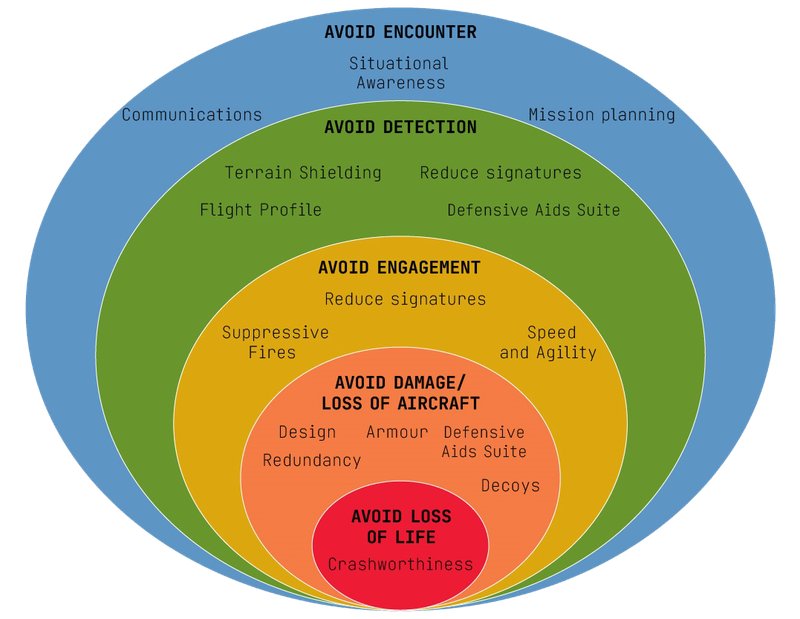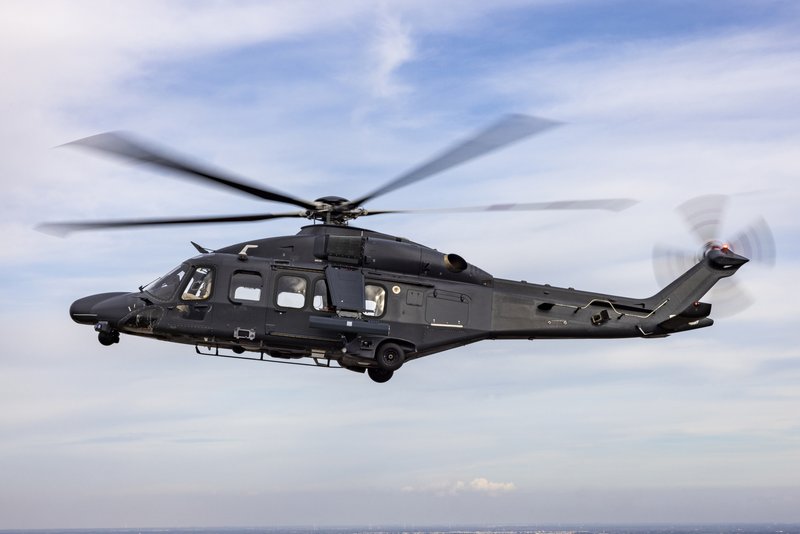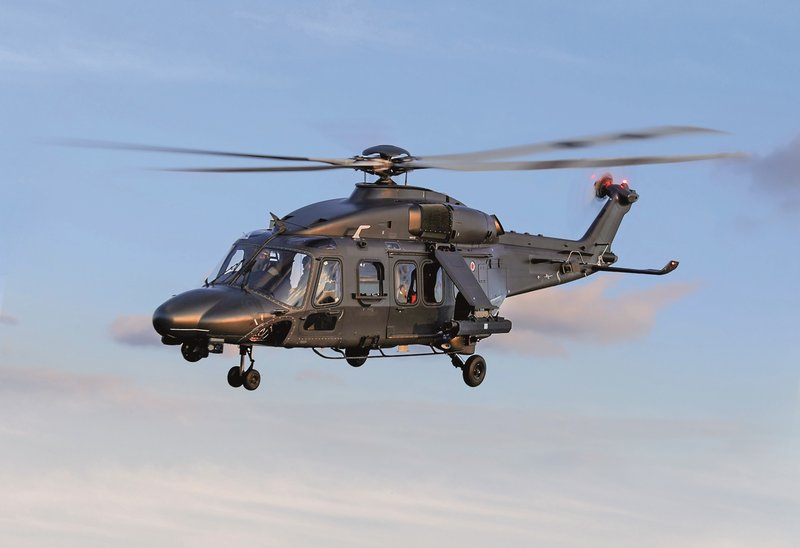AW149: Designed to Survive the Modern Battlefield (Sponsored)
This article is brought to you by Leonardo
From the earliest stages of its development, the AW149 was designed with the safety and security of battlefield troops in mind. To achieve this, Leonardo’s design philosophy adopts a ‘Survivability Onion’ approach. This article will discuss how the AW149 has survivability at its core.
▶️ WATCH: AW149 - The Modern Battlefield Platform
Avoid Loss of Life

Leonardo considers the ‘Survivability Onion’ from the inside out, this has ensured that the AW149 is designed from the outset to meet the exacting crashworthiness standards required by the UK Ministry of Defence (MOD). To achieve this, a high fidelity ‘Digital Twin’ was used at the AW149 design stage, simulating the effects of different crash cases, including the benchmark vertical crash case. In doing so, Leonardo was able to evaluate the airframe structure of the AW149 – which remained intact during simulation protecting crew and cabin occupants and enabling safe egress.
These simulations were then compared with an actual observed behaviour crash test that saw a fuel cell dropped from 50 feet. This test correlated at high levels with simulation results, as well as a robust airframe, the AW149 fuel tanks and fuel cut-off features are also designed to prevent fire in the event of a crash, further increasing survivability.
As Mike Overd, Chief Engineer for UK Military Aircraft, explains: “It’s an important factor to remember that 95% of all survivable crashes are going to be less severe than this vertical crash case, so we have a very high confidence level that the occupants can survive the vast majority of crashes.”
Avoid Loss of Aircraft
In addition to high levels of crashworthiness, the AW149 is a platform with very low vulnerability. It has an outstanding ability to withstand enemy fire and avoid damage, which is similarly considered in the design process. The AW149 boasts excellent redundancy of its critical systems, which are separated from one another on the platform to minimise the risk of them being disabled from small arms fire. Leonardo has also designed self-sealing fuel tanks and ballistic protection solutions for the cabin and cockpit, in addition to the main and tail rotors.

Vulnerability software was used to achieve this. Mike states: “During the initial design […] we simulated the aircraft behaviour using the same modelling techniques used by UK MOD.” Leonardo’s analysis demonstrated that AW149’s blades can withstand 12.7mm armour-piercing incendiary bullets – not just the tailing edge, but damage to the load bearing spar.
Furthermore, residual strength tests show that in the event of damage, AW149 blades can withstand the strain of a full mission profile for over 90 minutes and still be able to land safely. Likewise, all gearboxes can continue to operate at cruise flight power after oil loss for up to 50 minutes. This reflects 100 nautical miles of flight, giving crew an increased envelope to land in a friendly zone.
Avoid Detection & Engagement
Alongside its robust airframe, the AW149 platform is equipped with systems to help avoid detection in hostile environments and engagement with threats such as Man-Portable Air Defence Systems (MANPADS).These weapons are a great threat to military helicopters, and can be fired from almost anywhere with high lethality.
Leonardo has worked with colleagues at Davis Engineering to develop a new infrared (IR) suppression system to overcome such threats. IR suppression reduces the range at which an IR missile can detect and lock onto the aircraft, and improves the effectiveness of aircraft countermeasures. Mark Burnand, Chief Test Pilot at Leonardo Helicopters UK, says, “We’ve recorded over 35 test and evaluation flying hours with this installation on-board the AW149 and the results have been really impressive, delivering a 75% reduction in Band IV IR signature recognition, at all azimuth and elevation angles around the aircraft. This reduction is of vital importance when it comes to reducing vulnerability from heat-seeking missiles, because Band IV IR is the wavelength that these missiles typically lock onto.”

The AW149 is also currently fitted with a Leonardo Defensive Aids System (DAS), which works to provide measures in avoiding detection and engagement on an increasingly modern battlefield. These include a radar warning receiver, a missile warning sensor, a laser warning receiver and chaff and flare.
The current timeline for the UK MOD’s New Medium Helicopter requirement presents an opportunity to expand upon these DAS capabilities. Work is already underway with Leonardo’s Electronic Warfare experts in Luton to develop next generation DAS for the AW149.
While some elements of survivability can be improved with the addition of role-fit mission equipment, the AW149 was designed from the outset to survive in modern theatre and is battle ready.
More from Industry Spotlights
-
![The power of partnership: GDMS–UK deepens cooperation with the British Army]()
The power of partnership: GDMS–UK deepens cooperation with the British Army
In Conversation: Shephard's Gerrard Cowan talks to General Dynamics Mission Systems–United Kingdom’s Chris Burrows about how the company's UK TacCIS business is reshaping battlefield communications through sustained customer engagement, accelerated innovation and ecosystem collaboration.
-
![Expanded focus – unleashing the potential of commercial SATCOM for defence]()
Expanded focus – unleashing the potential of commercial SATCOM for defence
In conversation... Intelsat's Ray Lindenmayer talks to Shephard's Gerrard Cowan about the new capabilities advanced commercial SATCOM technologies can provide for military customers, and how industry and government can best work together to achieve maximum effect in orbit.
-
![Enhancing education: How CAE is embracing new technology to boost military training]()
Enhancing education: How CAE is embracing new technology to boost military training
In Conversation... Shephard's Gerrard Cowan talks to CAE's Marc-Olivier Sabourin about how the training and simulation industry can help militaries achieve essential levels of readiness by leveraging new technology, innovative procurement methods and a truly collaborative approach.
-
![Why tactical UAVs are winning on the future battlefield (Podcast)]()
Why tactical UAVs are winning on the future battlefield (Podcast)
In Conversation: In this special edition of the Shephard Defence Podcast, Tony Skinner sits down with Dan Slasky, President and CEO of Aeronautics, to explore how cutting-edge tactical unmanned aerial systems are reshaping today’s battlefields.
-
![Fincantieri’s Vulcano Class: a new era of versatility and innovation in naval operations]()
Fincantieri’s Vulcano Class: a new era of versatility and innovation in naval operations
Logistic support ships (LSS) are essential for sustained naval operations, especially during extended deployments far from home ports.
-
![Need more flexibility in battle management system delivery?]()
Need more flexibility in battle management system delivery?
Systematic’s newest solution, SitaWare BattleCloud, brings greater flexibility to combat information systems and C4ISR.
























